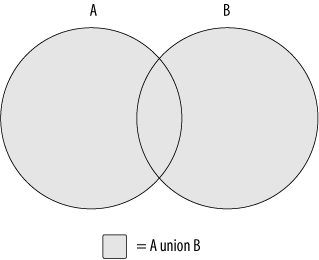Chapter 6. Working with Sets
Although you can interact with the data in a database one row at a time, relational databases are really all about sets. You have seen how tables can be created via queries or subqueries, made persistent via insert statements, and brought together via joins; this chapter will explore how multiple tables can be combined using various set operators.
Set Theory Primer
In many parts of the world, basic set theory is included in elementary-level math curriculums. Perhaps you recall looking at something like what is shown in Figure 6-1.
 |
The shaded area in Figure 6-1 represents the union of sets A and B, which is the combination of the two sets (with any overlapping regions included only once). Is this starting to look familiar? If so, then you’ll finally get a chance to put that knowledge to use; if not, don’t worry, because it’s easy to visualize using a couple of diagrams.
Using circles to represent two data sets (A and B), imagine a subset of data that is common to both sets; this common data is represented by the overlapping area shown in Figure 6-1. Since set theory is rather uninteresting without an overlap between data sets, I will use the same diagram to illustrate each set operation. There is another set operation that is concerned only with the overlap between two data sets; this operation is known as the intersection and ...
Get Learning SQL now with the O’Reilly learning platform.
O’Reilly members experience books, live events, courses curated by job role, and more from O’Reilly and nearly 200 top publishers.

